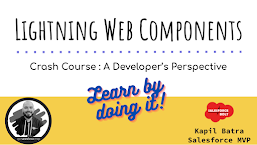LWC Stack is Lightning Web Component tutorial series by Salesforce MVP Kapil Batra. In this series you will find LWC tutorials from beginner to intermediate level.
So if you are working on it or planning to learn LWC then this video series is for you. Let's learn and grow together !
Please check complete code below from LWC Stack EP-31
The lightning/empApi module provides access to methods for subscribing to a streaming channel and listening to event messages. All streaming channels are supported, including channels for platform events, PushTopic events, generic events, and Change Data Capture events. This component requires API version 44.0 or later.
The lightning/empApi module uses a shared CometD connection, enabling you to run multiple streaming apps in a single browser session. The connection is not shared among multiple user sessions.
In a component's Javascript file, import methods from the lightning/empApi module using this syntax.
import { subscribe, unsubscribe, onError, setDebugFlag, isEmpEnabled } from 'lightning/empApi';
The available methods are described below.
This example subscribes to a streaming channel when you click the Subscribe button. It logs received event messages to the JavaScript console in your browser. The Unsubscribe button lets you stop the subscription and stop receiving event messages. This example uses the default streaming channel of /event/Test__e and assumes that the Test__e platform event is defined. Replace the default value with the desired channel name. In my case the event name is CustomEvent__e.
Create a platform event and add some custom fields
HTML
1 2 3 4 5 6 7 8 9 10 11 12 13 14 15 16 17 18 19 20 21 22 23 24 25 26 27 28 29 30 31 32 33 34 35 | <template>
<lightning-card title="EmpApi Example" icon-name="custom:custom14">
<div class="slds-m-around_medium">
<p>
Use the buttons below to subscribe and unsubscribe to a streaming
channel!
</p>
<lightning-input
label="Channel Name"
value={channelName}
onchange={handleChannelName}
></lightning-input>
<br />
<lightning-button
variant="success"
label="Subscribe"
title="Subscribe"
onclick={handleSubscribe}
disabled={isSubscribeDisabled}
class="slds-m-left_x-small"
></lightning-button>
<lightning-button
variant="destructive"
label="Unsubscribe"
title="Unsubscribe"
onclick={handleUnsubscribe}
disabled={isUnsubscribeDisabled}
class="slds-m-left_x-small"
></lightning-button>
<br />
<br />
<p>Message from Salesforce Bolt - {messageBody}</p>
</div>
</lightning-card>
</template>
|
JavaScript
1 2 3 4 5 6 7 8 9 10 11 12 13 14 15 16 17 18 19 20 21 22 23 24 25 26 27 28 29 30 31 32 33 34 35 36 37 38 39 40 41 42 43 44 45 46 47 48 49 50 51 52 53 54 55 56 57 58 59 60 61 62 63 64 65 66 67 68 69 70 71 72 73 74 | import { LightningElement, track } from "lwc";
import {
subscribe,
unsubscribe,
onError,
setDebugFlag,
isEmpEnabled
} from "lightning/empApi";
export default class EmpAPIListner extends LightningElement {
@track messageBody = "";
channelName = "/event/CustomEvent__e";
isSubscribeDisabled = false;
isUnsubscribeDisabled = !this.isSubscribeDisabled;
subscription = {};
// Tracks changes to channelName text field
handleChannelName(event) {
this.channelName = event.target.value;
}
// Initializes the component
connectedCallback() {
// Register error listener
this.registerErrorListener();
}
// Handles subscribe button click
handleSubscribe() {
const thisReference = this;
// Callback invoked whenever a new event message is received
const messageCallback = function (response) {
thisReference.messageBody = response.data.payload.message__c;
console.log("###New message received ", response.data.payload.message__c);
// Response contains the payload of the new message received
};
// Invoke subscribe method of empApi. Pass reference to messageCallback
subscribe(this.channelName, -1, messageCallback).then((response) => {
// Response contains the subscription information on subscribe call
console.log(
"Subscription request sent to: ",
JSON.stringify(response.channel)
);
this.subscription = response;
this.toggleSubscribeButton(true);
});
}
// Handles unsubscribe button click
handleUnsubscribe() {
this.toggleSubscribeButton(false);
// Invoke unsubscribe method of empApi
unsubscribe(this.subscription, (response) => {
console.log("unsubscribe() response: ", JSON.stringify(response));
// Response is true for successful unsubscribe
});
}
toggleSubscribeButton(enableSubscribe) {
this.isSubscribeDisabled = enableSubscribe;
this.isUnsubscribeDisabled = !enableSubscribe;
}
registerErrorListener() {
// Invoke onError empApi method
onError((error) => {
console.log("Received error from server: ", JSON.stringify(error));
// Error contains the server-side error
});
}
} |
Apex in Anonymous Window in developer console
1 2 | CustomEvent__e event = new CustomEvent__e(message__c = 'You are Awesome...'); Database.SaveResult result = EventBus.publish(event); |
Output
















1 Comments
hello, how can I add an event to the code that I have below, that when the user is navigating between tabs in salesforce (different cases), to initialize the recordid again in my aura component? do you have an idea?
ReplyDelete